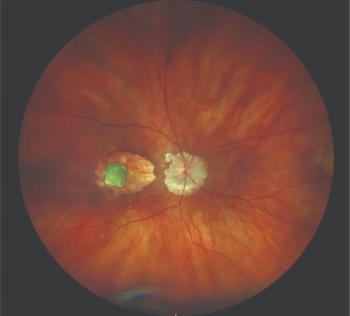
Optic cup volume changes seen in tamoxifen, controls
A study using confocal scanning laser ophthalmoscopy supports a previous report that breast cancer patients treated with tamoxifen have a significantly smaller optic cup volume compared with healthy controls.
Key Points
"Tamoxifen has been rarely associated with retinopathy and somewhat more commonly with nonspecific visual complaints," said Julie Falardeau, MD, assistant professor of ophthalmology, Oregon Health & Science University, Portland. "The latter are generally vague descriptions of changes in vision often occurring without any abnormalities noted in a standard ophthalmic exam. The findings of this study, using an advanced imaging technology, raise the possibility that the visual complaints may be explained by some subclinical changes in the optic nerve head."
The investigators reported their findings in a paper published online (Eisner A, et al. Breast Cancer Res Treat. 2007 Jan 27; Epub ahead of print). Optic nerve head topography was evaluated in the three groups of women using a confocal scanning laser ophthalmoscope (Heidelberg Retinal Tomograph II [HRT II], Heidelberg Engineering). All of the study participants were amenorrheic, between the ages of 40 and 69 years, and met predefined rigorous criteria for having excellent ocular health. The breast cancer patients all were treated for 2 years or less.
According to the study authors, the findings have implications for evaluation of tamoxifen-treated women with visual complaints. They emphasize, however, that the findings do not provide a basis for directing therapy.
Alvin Eisner, PhD, lead author of the study added, "Unless and until tamoxifen is documented to induce changes in the optic cup over time and those anatomic changes correspond to changes in vision, the [confocal scanning laser ophthalmoscope] findings should not be used to direct therapy. Any such decisions would be premature at best and incorrect at worst." Dr. Eisner is senior scientist and research associate professor of ophthalmology, Oregon Health & Science University.
The findings of this study also may have relevance for ophthalmologists examining patients with glaucoma or suspected glaucoma because evaluation of optic cup appearance is important for monitoring those conditions.
In a previous study by other investigators, about 13% of women using tamoxifen reported vision problems. Interestingly, these vision problems were more strongly associated with serum tamoxifen levels than they were with more well-known side effects of tamoxifen, such as hot flashes.
In the course of documenting in the laboratory that tamoxifen use was associated with color perception changes (Eisner A, Incognito LJ. Vision Res. 2006;46: 1816-1822), Dr. Eisner further undertook imaging studies that found that women taking tamoxifen had smaller optic cups compared with age-matched normal controls. To investigate that observation further, the current comparative investigation was undertaken using both breast cancer patients taking anastrozole and healthy women as controls.
Newsletter
Don’t miss out—get Ophthalmology Times updates on the latest clinical advancements and expert interviews, straight to your inbox.





